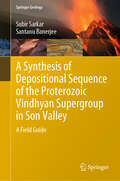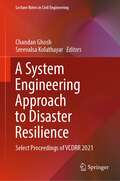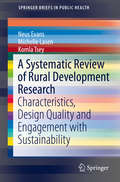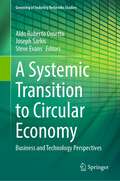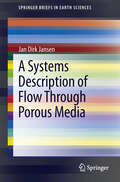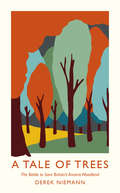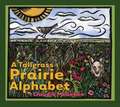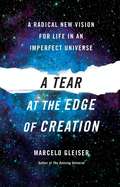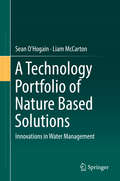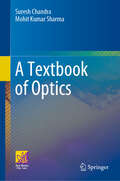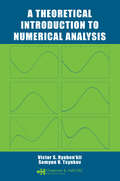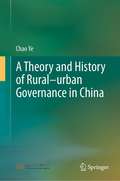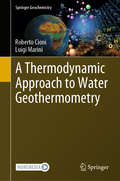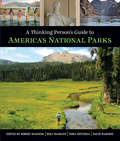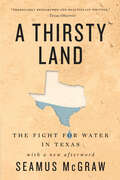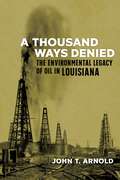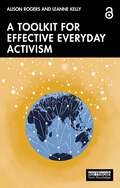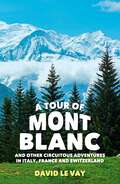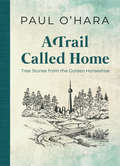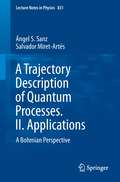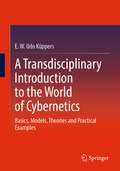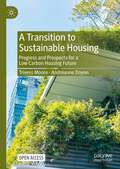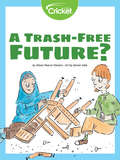- Table View
- List View
A Synthesis of Depositional Sequence of the Proterozoic Vindhyan Supergroup in Son Valley: A Field Guide (Springer Geology)
by Santanu Banerjee Subir SarkarThis book offers extensive information on the course of sedimentation in the Proterozoic Vindhyan Basin and the potential record of ancient life stored within the rocks. It covers topics ranging from facies analysis to sequence-building, from carbonates to siliciclastics, and mixed lithology and life records from microbial to potentially eukaryotes, along with the basin evolutionary history. Further, the book includes 75 color photographs and accompanying hand-sketches to help readers grasp key aspects of Vindhyan Geology. Vindhyan rocks are well known for their excellent preservation of microbial record of earth. Offering a student-friendly field guide containing detailed route maps, geological maps and a wealth of visual examples, it is also extremely useful in terms of understanding the microbe-dominated environments on Mars.
A System Engineering Approach to Disaster Resilience: Select Proceedings of VCDRR 2021 (Lecture Notes in Civil Engineering #205)
by Sreevalsa Kolathayar Chandan GhoshThis book presents the select proceedings of the Virtual Conference on Disaster Risk Reduction (VCDRR 2021). It emphasizes on the role of civil engineering for a disaster resilient society. Various topics covered in this book are risk assessment, prevention, mitigation, preparedness and response, early warning system, hazard mapping, engineering innovations for hazard mitigation, and safe design of structures. This book is a comprehensive volume on disaster risk reduction (DRR) and its management for a sustainable built environment. This book will be useful for the students, researchers, policy makers and professionals working in the area of civil engineering, especially disaster management.
A Systematic Review of Rural Development Research: Characteristics, Design Quality and Engagement with Sustainability (SpringerBriefs in Public Health)
by Komla Tsey Neus Evans Michelle LasenRapid urbanisation, inequalities in income and service levels within and between communities, and population and economic decline are challenging the viability of rural communities worldwide. Achieving healthy and viable rural communities in the face of rapidly changing social, ecological and economic conditions is a declared global priority. As a result, governments all over the world, in both developed and developing countries, are now prioritizing rural and regional development through policies and programs aimed at enhancing the livelihoods of people living in rural regions. In recognition of the important roles that research can play in rural development, a range of systematic literature reviews have rightly examined key priorities in rural development including education, gender, economic development (especially agriculture), and health and nutrition (see Department for International Development [DFID], 2011). However, none of these works has systematically examined the extent to which rural development as a field of research is progressing towards facilitating sustainable change. This book evaluates trends in rural development research across the five continental regions of the world. Specifically, it assesses the total publication output relating to rural development, the types of publications, their quality and impact over the last three decades. Additionally, it evaluates the continental origins of the publications as well as the extent to which such publications engage with issues of sustainability. The aim is to determine whether the rural development field is growing in a manner that reflects research and policy priorities and broader social trends such as sustainability. Development policy makers, practitioners, those teaching research methods and systematic literature reviews to undergraduate and graduate students, and researchers in general will find the book both topical and highly relevant.
A Systemic Transition to Circular Economy: Business and Technology Perspectives (Greening of Industry Networks Studies #12)
by Steve Evans Joseph Sarkis Aldo Roberto OmettoThe book will explore, using multiple perspectives from multiple contributors, two main aspects for circular economy (CE) business and technology (B&T): systems and value perspectives. Going beyond a linear-economic perspective--the traditional perspective--CE needs to develop intentional and integrated paths to help restore physical resources and regenerate the functions of natural and anthropic systems, creating greater economic and social opportunities, with environmentally positive outcomes. Whether this is feasible and possible within the context of CE and B&T is something that will be central to the contributions made in this book. A major objective of the book is to deliver practical and fundamental knowledge of B&T CE insights combining a systems perspective and value creation for socio-technical innovation leading to sustainable transitions and effective transformations. Based on those key aspects, the book is structured in two parts, one from a more theoretical and conceptual basis in Part 1, and a more applied perspective in Part 2. The chapters in Part 1 are presented through the lens of business and systems transitions. In Part 2, the chapters present the opportunities and the journeys from real case studies of companies engaged in circular business strategies, processes, practices, and technologies.
A Systems Description of Flow Through Porous Media (SpringerBriefs in Earth Sciences)
by Jan Dirk JansenThis text forms part of material taught during a course in advanced reservoir simulation at Delft University of Technology over the past 10 years. The contents have also been presented at various short courses for industrial and academic researchers interested in background knowledge needed to perform research in the area of closed-loop reservoir management, also known as smart fields, related to e.g. model-based production optimization, data assimilation (or history matching), model reduction, or upscaling techniques. Each of these topics has connections to system-theoretical concepts. The introductory part of the course, i.e. the systems description of flow through porous media, forms the topic of this brief monograph. The main objective is to present the classic reservoir simulation equations in a notation that facilitates the use of concepts from the systems-and-control literature. Although the theory is limited to the relatively simple situation of horizontal two-phase (oil-water) flow, it covers several typical aspects of porous-media flow. The first chapter gives a brief review of the basic equations to represent single-phase and two-phase flow. It discusses the governing partial-differential equations, their physical interpretation, spatial discretization with finite differences, and the treatment of wells. It contains well-known theory and is primarily meant to form a basis for the next chapter where the equations will be reformulated in terms of systems-and-control notation.The second chapter develops representations in state-space notation of the porous-media flow equations. The systematic use of matrix partitioning to describe the different types of inputs leads to a description in terms of nonlinear ordinary-differential and algebraic equations with (state-dependent) system, input, output and direct-throughput matrices. Other topics include generalized state-space representations, linearization, elimination of prescribed pressures, the tracing of stream lines, lift tables, computational aspects, and the derivation of an energy balance for porous-media flow. The third chapter first treats the analytical solution of linear systems of ordinary differential equations for single-phase flow. Next it moves on to the numerical solution of the two-phase flow equations, covering various aspects like implicit, explicit or mixed (IMPES) time discretizations and associated stability issues, Newton-Raphson iteration, streamline simulation, automatic time-stepping, and other computational aspects. The chapter concludes with simple numerical examples to illustrate these and other aspects such as mobility effects, well-constraint switching, time-stepping statistics, and system-energy accounting. The contents of this brief should be of value to students and researchers interested in the application of systems-and-control concepts to oil and gas reservoir simulation and other applications of subsurface flow simulation such as CO2 storage, geothermal energy, or groundwater remediation.
A Tale of Trees: How Britain Nearly Lost its Ancient Woodland
by Derek NiemannWe are a nation that loves its ancient woods and trees. But in the space of just 40 years, more than a third of our ancient woods were destroyed. How and why did this happen? A Tale of Trees is the untold story of how we nearly lost our greatest national treasure.
A Tale of Trees: How Britain Nearly Lost its Ancient Woodland
by Derek NiemannWe are a nation that loves its ancient woods and trees. But in the space of just 40 years, more than a third of our ancient woods were destroyed. How and why did this happen? A Tale of Trees is the untold story of how we nearly lost our greatest national treasure.
A Tallgrass Prairie Alphabet
by Claudia Mcgehee"Aromatic aster, butterfly weed, coyote, dickcissel..." Learn your ABCs with these animals and plants unique to the U.S. prairie.
A Tear at the Edge of Creation: A Radical New Vision for Life in an Imperfect Universe
by Marcelo GleiserFor millennia, shamans and philosophers, believers and nonbelievers, artists and scientists have tried to make sense of our existence by suggesting that everything is connected, that a mysterious Oneness binds us to everything else. People go to temples, churches, mosques, and synagogues to pray to their divine incarnation of Oneness. Following a surprisingly similar notion, scientists have long asserted that under Nature's apparent complexity there is a simpler underlying reality. In its modern incarnation, this Theory of Everything would unite the physical laws governing very large bodies (Einstein's theory of relativity) and those governing tiny ones (quantum mechanics) into a single framework. But despite the brave efforts of many powerful minds, the Theory of Everything remains elusive. It turns out that the universe is not elegant. It is gloriously messy. Overturning more than twenty-five centuries of scientific thought, award-winning physicist Marcelo Gleiser argues that this quest for a Theory of Everything is fundamentally misguided, and he explains the volcanic implications this ideological shift has for humankind. All the evidence points to a scenario in which everything emerges from fundamental imperfections, primordial asymmetries in matter and time, cataclysmic accidents in Earth's early life, and duplication errors in the genetic code. Imbalance spurs creation. Without asymmetries and imperfections, the universe would be filled with nothing but smooth radiation. A Tear at the Edge of Creation calls for nothing less than a new "humancentrism" to reflect our position in the universal order. All life, but intelligent life in particular, is a rare and precious accident. Our presence here has no meaning outside of itself, but it does have meaning. The unplanned complexity of humankind is all the more beautiful for its improbability. It's time for science to let go of the old aesthetic that labels perfection beautiful and holds that "beauty is truth. " It's time to look at the evidence without centuries of monotheistic baggage. In this lucid, down-to-earth narrative, Gleiser walks us through the basic and cutting-edge science that fueled his own transformation from unifier to doubter--a fascinating scientific quest that led him to a new understanding of what it is to be human.
A Technology Portfolio of Nature Based Solutions: Innovations In Water Management
by Sean O'Hogain Liam McCartonThis book aims to define the concept of Nature Based Solutions (NBS) by using case studies from members of the European Innovation Partnership (EIP) Water Action Group - NatureWat. NBS is defined and characterized in terms of water source, contaminants, removal mechanisms and resource recovery potential. The case studies presented illustrate the appropriateness of NBS promoting climate resilience. Readers will discover a technology portfolio based on a number of demonstration sites in the fields of climate change adaption, water and wastewater treatment, resource recovery and re-use, and restoring ecosystems to promote the use of nature based solutions. The chapters in the book present a multidisciplinary approach involving social scientists, governance representatives and engineers. The underlying philosophy of the book is the circular economy of water which prioritizes the concepts of resource recovery and resilience within water resource management. The first section of the book presents the background and objectives of the study, and how the action group aims to promote the use of nature based solutions through its diverse technology portfolio. Particular attention is given to the goals of finding cost-effective solutions for wastewater treatment, climate change mitigation, disaster risk reduction, flood protection, greening cities, degraded areas restoration and biodiversity preservation. The chapter on reclaimed water addresses water reuse and defines the term fit for purpose. Barriers and limitations related to NBS for water resource management are discussed. The book concludes with several case studies at local, regional and global levels which illustrate a new approach to water management. These case studies illustrate the application of a hybrid green and grey infrastructure system. This is a combination of traditional engineered infrastructure with nature based solutions which combines centralised and decentralised systems to optimise the reclamation of water for reuse in a fit for purpose model.
A Textbook of Optics
by Suresh Chandra Mohit Kumar SharmaThis book is designed to serve as a textbook for courses offered to upper-undergraduate students enrolled in physics and explains the broad spectrum of optics in a student-friendly way. The textbook covers the entire syllabi of the undergraduate courses being taught at both national and international universities including adequate details of mathematical expressions to help students understand the subject matter. The topics covered in this book are reflection, refraction, cardinal points, interference, Fresnel diffraction, Fraunhofer diffraction, lasers and holography, fiber optics, etc. This book explains each topic in a simple and lucid language with the help of solved problems. Exercises with multiple choice questions have been given at the end of each chapter for self-assessment. The detailed coverage and pedagogical tools make this an ideal textbook for students and researchers enrolled in senior undergraduate and beginning postgraduate physics students.
A Theoretical Introduction to Numerical Analysis
by Victor S. Ryaben'kii Semyon V. TsynkovA Theoretical Introduction to Numerical Analysis presents the general methodology and principles of numerical analysis, illustrating these concepts using numerical methods from real analysis, linear algebra, and differential equations. The book focuses on how to efficiently represent mathematical models for computer-based study. An access
A Theory and History of Rural–urban Governance in China
by Chao YeThis book divides the history of China's rural-urban relations into three stages: antagonism, integration and re-antagonism, and demonstrates that the two coupled variables i.e., policy-culture and coast-trade are the most crucial to urbanization and rural-urban governance in China from ancient times till now. From the perspective of a combination of history and geography, this book puts forward a new theory which is mainly based on Adam Smith's theory and other theories about rural-urban relationship and reinterprets the process and driving forces of evolutionary history of rural-urban relationship over 5,000 years in China. It is useful for researchers and scholars specialized in such fields as rural and urban studies, economics, geography, management and planning for reference.
A Thermodynamic Approach to Water Geothermometry (Springer Geochemistry)
by Roberto Cioni Luigi MariniThis book explores water geothermometry, a highly relevant topic in the exploration and exploitation of geothermal energy. Presenting theoretical geothermometers and indicators of CO2 fugacity, it describes a rigorous new approach entirely based on thermodynamics. The book will appeal to geothermal geoscientists, especially those working in research institutions and companies around the globe. It is also of interest to students on advanced courses in applied geochemistry, water–rock interaction and other related areas.
A Thinking Person's Guide to America's National Parks
by Robert Manning Rolf Diamant Nora Mitchell David HarmonThe book delves into issues affecting an array of parks: the iconic western national parks like Yellowsto≠ the urban parks such as Golden Gate National Recreation Area; historic sites including the Statue of Liberty National Monument and Gettysburg National Military Park; and cultural areas like Mesa Verde National Park that are among America's over 400 national parks. Twenty-three essays from contributing authors with deep personal and professional connections to the national parks serve as expert guides to places in the park system where: much of the nation's biological and cultural diversity is represented;ideas such as freedom, civil rights, and conservation were conceived;vast wilderness offers solitude and reflection;storied landscapes preserve a sense of place;the balance between recreation and preservation is tested;research and learning engage the next generation;the dynamics of nature are being shaped by a changing climate; and innovations in technology, sustainability, and stewardship provide a sense of purpose and hope.
A Thirsty Land: The Fight for Water in Texas (Natural Resources Management and Conservation)
by Seamus McGraw“An important story not just about [Texas’s] water history, but also about its social, economic, and political identity” (Western Historical Quarterly).As a changing climate threatens the whole country with deeper droughts and more furious floods that put ever more people and property at risk, Texas has become a bellwether state for water debates. Will there be enough water for everyone? Is there the will to take the steps necessary to defend ourselves against the sea? Is it in the nature of Americans to adapt to nature in flux?The most comprehensive—and comprehensible—book on contemporary water issues, A Thirsty Land delves deep into the challenges faced not just by Texas but also by the nation, as we struggle to find a way to balance the changing forces of nature with our own ever-expanding needs. Part history, part science, part adventure story, and part travelogue, this book puts a human face on the struggle to master that most precious and capricious of resources, water. Seamus McGraw goes to the taproots, talking to farmers, ranchers, businesspeople, and citizen activists, as well as to politicians and government employees. Their stories provide chilling evidence that Texas—and indeed the nation—is not ready for the next devastating drought, the next catastrophic flood. Ultimately, however, A Thirsty Land delivers hope. This deep dive into one of the most vexing challenges facing Texas and the nation offers glimpses of the way forward in the untapped opportunities that water also presents.“A hard look at a hard problem: finding sufficient water to live in a place without much of it. . . . McGraw’s fine book serves as a useful guide. Observers of Western waterways will want to have this on their shelves alongside the likes of Marc Reisner and Charles Bowden.” —Kirkus Reviews“In stark prose that often gleams like a bone pile bleached in the sun, McGraw travels back and forth across Texas to give a free-ranging but deadeye view of the crisis on the horizon.” —Texas Monthly“It’s hard to write about the slow creep of environmental crises like drought without resorting to shock tactics or getting lost in the weeds . . . [McGraw] draws out the conflicts in compelling ways by drilling into the plight of individual water users. Even if you feel no connection to Texas, these stories are relevant to every part of the country.” —Outside“Interviewing both scientific experts and everyday water users, [McGraw] clearly delineates the competing interests, describes political and geological reality, and makes a compelling argument for statewide water policy that utilizes modern technology and fairly weighs parochial needs against the good of the whole.” —Arizona Daily Star, Southwest Books of the Year
A Thirsty Land: The Fight for Water in Texas (Natural Resources Management and Conservation)
by Seamus McGraw“An important story not just about [Texas’s] water history, but also about its social, economic, and political identity” (Western Historical Quarterly).As a changing climate threatens the whole country with deeper droughts and more furious floods that put ever more people and property at risk, Texas has become a bellwether state for water debates. Will there be enough water for everyone? Is there the will to take the steps necessary to defend ourselves against the sea? Is it in the nature of Americans to adapt to nature in flux?The most comprehensive—and comprehensible—book on contemporary water issues, A Thirsty Land delves deep into the challenges faced not just by Texas but also by the nation, as we struggle to find a way to balance the changing forces of nature with our own ever-expanding needs. Part history, part science, part adventure story, and part travelogue, this book puts a human face on the struggle to master that most precious and capricious of resources, water. Seamus McGraw goes to the taproots, talking to farmers, ranchers, businesspeople, and citizen activists, as well as to politicians and government employees. Their stories provide chilling evidence that Texas—and indeed the nation—is not ready for the next devastating drought, the next catastrophic flood. Ultimately, however, A Thirsty Land delivers hope. This deep dive into one of the most vexing challenges facing Texas and the nation offers glimpses of the way forward in the untapped opportunities that water also presents.“A hard look at a hard problem: finding sufficient water to live in a place without much of it. . . . McGraw’s fine book serves as a useful guide. Observers of Western waterways will want to have this on their shelves alongside the likes of Marc Reisner and Charles Bowden.” —Kirkus Reviews“In stark prose that often gleams like a bone pile bleached in the sun, McGraw travels back and forth across Texas to give a free-ranging but deadeye view of the crisis on the horizon.” —Texas Monthly“It’s hard to write about the slow creep of environmental crises like drought without resorting to shock tactics or getting lost in the weeds . . . [McGraw] draws out the conflicts in compelling ways by drilling into the plight of individual water users. Even if you feel no connection to Texas, these stories are relevant to every part of the country.” —Outside“Interviewing both scientific experts and everyday water users, [McGraw] clearly delineates the competing interests, describes political and geological reality, and makes a compelling argument for statewide water policy that utilizes modern technology and fairly weighs parochial needs against the good of the whole.” —Arizona Daily Star, Southwest Books of the Year
A Thousand Ways Denied: The Environmental Legacy of Oil in Louisiana
by John T. ArnoldFrom the hill country in the north to the marshy lowlands in the south, Louisiana and its citizens have long enjoyed the hard-earned fruits of the oil and gas industry’s labor. Economic prosperity flowed from pioneering exploration as the industry heralded engineering achievements and innovative production technologies. Those successes, however, often came at the expense of other natural resources, leading to contamination and degradation of land and water. In A Thousand Ways Denied, John T. Arnold documents the oil industry’s sharp interface with Louisiana’s environment. Drawing on government, corporate, and personal files, many previously untapped, he traces the history of oil-field practices and their ecological impacts in tandem with battles over regulation. Arnold reveals that in the early twentieth century, Louisiana helped lead the nation in conservation policy, instituting some of the first programs to sustain its vast wealth of natural resources. But with the proliferation of oil output, government agencies splintered between those promoting production and others committed to preventing pollution. As oil’s economic and political strength grew, regulations commonly went unobserved and unenforced. Over the decades, oil, saltwater, and chemicals flowed across the ground, through natural drainages, and down waterways. Fish and wildlife fled their habitats, and drinking-water supplies were ruined. In the wetlands, drilling facilities sat like factories in the midst of a maze of interconnected canals dredged to support exploration, manufacture, and transportation of oil and gas. In later years, debates raged over the contribution of these activities to coastal land loss.Oil is an inseparable part of Louisiana’s culture and politics, Arnold asserts, but the state’s original vision for safeguarding its natural resources has become compromised. He urges a return to those foundational conservation principles. Otherwise, Louisiana risks the loss of viable uses of its land and, in some places, its very way of life.
A Toolkit for Effective Everyday Activism
by Alison Rogers Leanne KellyThis book examines how everyday activists can enhance their effectiveness.Leanne Kelly and Alison Rogers unpack theories from the social sciences to help find meaning, explain these feelings of inertia, and provide strategies to overcome them. Through lessons learned over their careers as evaluators in non-profit organisations, Kelly and Rogers provide tools and strategies for measuring, improving, and sharing the effectiveness of planet-saving activities. They draw upon interviews with everyday people who are contributing to change in their homes, community groups, workplaces, and social settings to understand how they motivate and encourage others. The book concludes with a realistic look at individual expectations and focuses on how to prioritise self-care to ensure that activists can keep contributing in a way that maintains their wellbeing and balance.A Toolkit for Effective Everyday Activism empowers people to use theory, research, and practical tools to leverage their power so they can make the maximum contribution possible and sustain their efforts over the long term. It will be a great resource for individuals working and volunteering in community groups, NGOs, and non-profit and corporate organisations with an environmental focus.The Open Access version of this book, available at http://www. taylorfrancis.com, has been made available under a Creative Commons Attribution-Non Commercial-No Derivatives (CC-BY-NC-ND) 4.0 international license.The electronic version of this book was funded to publish Open Access through Taylor & Francis’ Pledge to Open, a collaborative funding open access books initiative. The full list of pledging institutions can be found on the Taylor & Francis Pledge to Open webpage
A Tour of Mont Blanc: And other circuitous adventures in Italy, France and Switzerland
by David Le VayOn New Year's Day, David makes a pact to tackle Western Europe's highest mountain, Mont Blanc. With his only daughter leaving for university and his fiftieth birthday approaching, walking 170 kilometres across a mountain range seems the perfect antidote. Humorous, reflective and poignant, this journey is full to bursting with stories to remember.
A Trail Called Home: Tree Stories from the Golden Horseshoe
by Paul O'HaraAn exploration of trees in the Golden Horseshoe and the stories they tell. Trees define so much of Canadian life, but many people, particularly in the Golden Horseshoe area of Ontario, don’t know that much about them. Granted, it is harder here: there are more trees that are native to this area than anywhere else in Canada. The great storytellers of the landscape, trees are looking glasses into the past. They speak of biology, ecology, and geology, as well as natural and human history. Through a greater understanding of trees, we can become more rooted to the land beneath our feet, and our place in it.
A Trajectory Description of Quantum Processes. II. Applications: A Bohmian Perspective (Lecture Notes in Physics #831)
by Ángel S. Sanz Salvador Miret-ArtésTrajectory-based formalisms are an intuitively appealing way of describing quantum processes because they allow the use of "classical" concepts. Beginning as an introductory level suitable for students, this two-volume monograph presents (1) the fundamentals and (2) the applications of the trajectory description of basic quantum processes. This second volume is focussed on simple and basic applications of quantum processes such as interference and diffraction of wave packets, tunneling, diffusion and bound-state and scattering problems. The corresponding analysis is carried out within the Bohmian framework. By stressing its interpretational aspects, the book leads the reader to an alternative and complementary way to better understand the underlying quantum dynamics.
A Transdisciplinary Introduction to the World of Cybernetics: Basics, Models, Theories and Practical Examples
by E. W. KüppersThis introduction to the world of cybernetics provides the basics and discusses the most important thought leaders, models as well as theories. Practical examples from the fields of biology, ecology, technology, society, and politics are used to illustrate the theoretical material. Questions at the end of the chapters stimulate reflection, and the author does not owe the answers. A central theme in all cybernetic considerations and a guiding theme of the book are information exchange and communication.
A Transition to Sustainable Housing: Progress and Prospects for a Low Carbon Housing Future
by Trivess Moore Andréanne DoyonThis open access book explores the environmental, social, and financial challenges of housing provision, and the urgent need for a sustainable housing transition. The authors explore how market failures have impacted the scaling up of sustainable housing and the various policy attempts to address this. Going beyond an environmental focus, the book explores a range of housing-related challenges including social justice and equity issues. Sustainability transitions theory is presented as a framework to help facilitate a sustainable housing transition and a range of contemporary case studies are explored on issues including high performing housing, small housing, shared housing, neighbourhood-scale housing, circular housing, and innovative financing for housing. It is an important new resource that challenges policy makers, planners, housing construction industry stakeholders, and researchers to rethink what housing is, how we design and construct it, and how we can better integrate impacts on households to wider policy development.
A Trash-Free Future?
by Alison Pearce StevensWhat happens to trash after the garbage truck picks it up? Where does it go? The problem of too much trash is hurting the planet. Recycling, reusing, composting and creating new ways to make less trash is a start! Learn to recycle old furniture, and how safer materials are being developed that can easily decompose. People are working hard every day on new ways to have a trash-free future! Are you?
